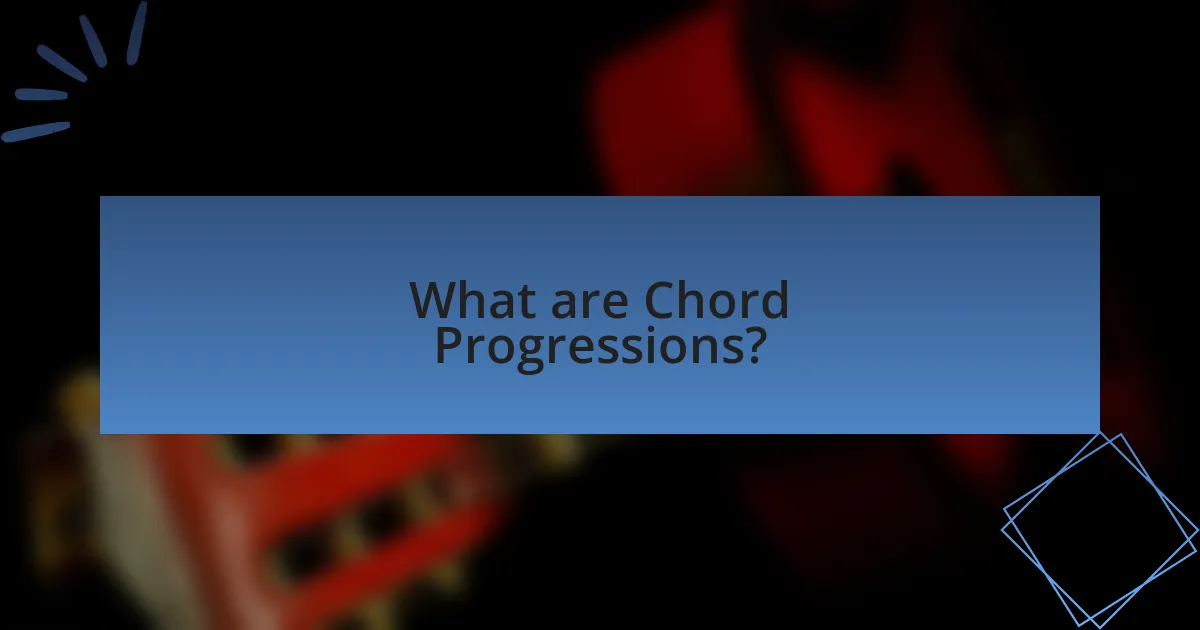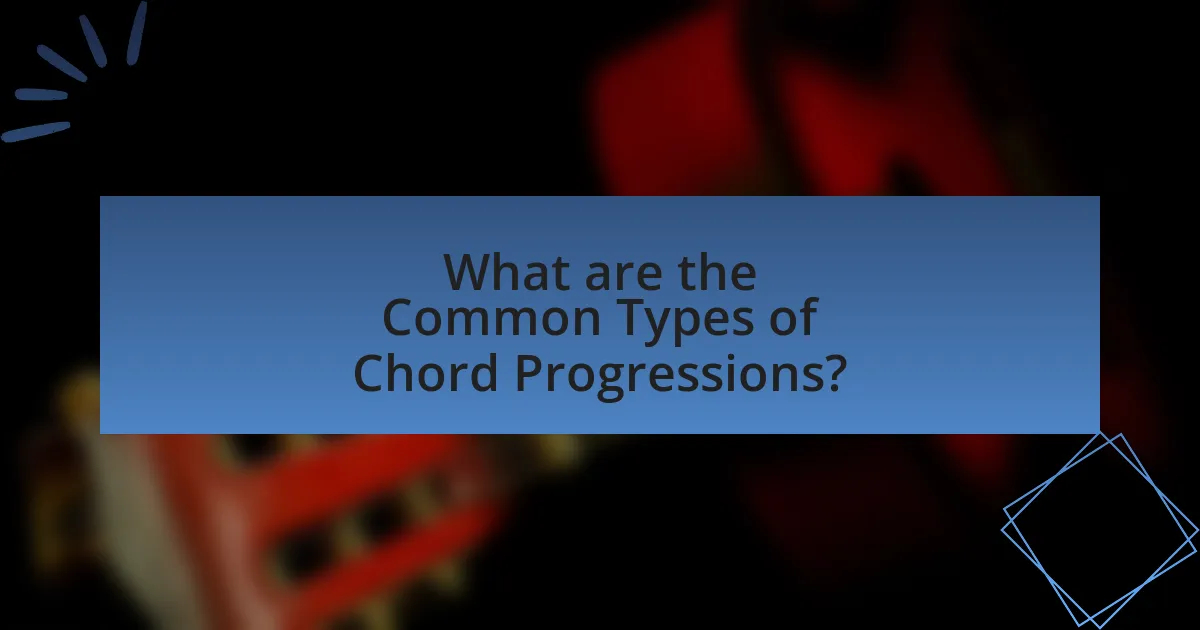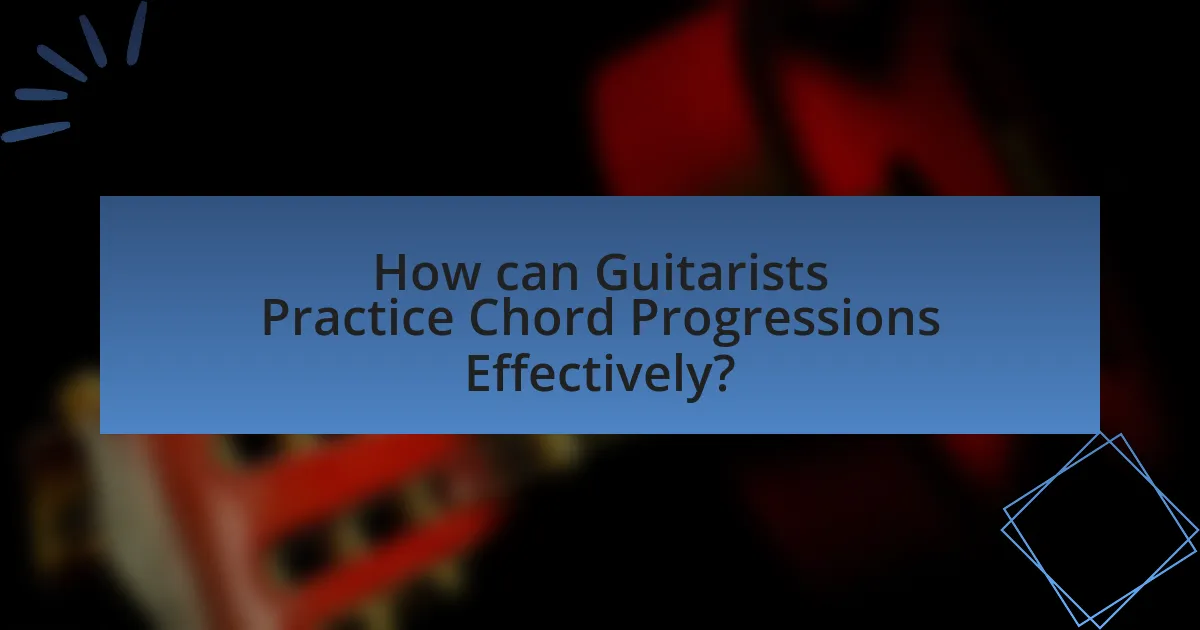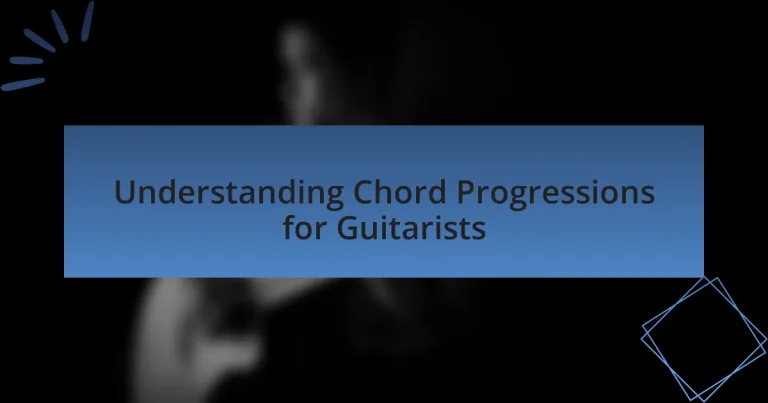Chord progressions are sequences of chords that form the harmonic foundation of music, influencing the emotional and structural flow of compositions. This article explores the significance of chord progressions for guitarists, detailing their role in songwriting, improvisation, and musical tension and resolution. Key concepts include the basic elements of chord progressions, common types such as I-IV-V and ii-V-I, and techniques for practicing and adapting these progressions across genres. Additionally, the article highlights the importance of ear training and effective practice strategies to enhance a guitarist’s proficiency in utilizing chord progressions.

What are Chord Progressions?
Chord progressions are sequences of chords played in succession, forming the harmonic foundation of a piece of music. They dictate the emotional and tonal direction of a song, influencing its overall feel and structure. For example, the I-IV-V progression, commonly used in various genres, consists of the first, fourth, and fifth chords of a key, creating a sense of resolution and movement. This foundational concept is essential for guitarists, as understanding chord progressions allows them to create, analyze, and perform music effectively.
How do Chord Progressions function in music?
Chord progressions function in music by establishing a sequence of chords that create a harmonic foundation for a piece. These progressions guide the emotional and structural flow of a composition, influencing how melodies interact with harmonies. For example, the I-IV-V-I progression is foundational in Western music, providing a sense of resolution and familiarity. This is evidenced by its prevalence in numerous genres, including pop, rock, and classical music, where it serves to evoke specific feelings and maintain listener engagement.
What are the basic elements of a Chord Progression?
The basic elements of a chord progression are chords, the sequence in which they are played, and the rhythm that accompanies them. Chords serve as the building blocks, providing harmonic structure, while the sequence determines the flow and emotional impact of the music. Rhythm adds timing and pace, influencing how the chords interact over time. These elements work together to create a cohesive musical experience, as seen in various genres where specific progressions evoke distinct feelings and styles.
How do Chord Progressions create musical tension and resolution?
Chord progressions create musical tension and resolution by establishing a sense of movement and expectation through the arrangement of chords. Tension arises when a progression leads to a chord that feels unresolved, often using dominant chords that create a pull towards the tonic chord, which provides resolution. For example, the V-I progression (dominant to tonic) is a classic example where the dominant chord (V) creates a strong desire to resolve to the tonic chord (I), fulfilling the listener’s expectation. This relationship is supported by the principles of functional harmony, where chords serve specific roles that guide the emotional trajectory of the music.
Why are Chord Progressions important for Guitarists?
Chord progressions are important for guitarists because they form the foundation of most musical compositions, dictating the harmonic structure and emotional tone of a piece. Understanding chord progressions allows guitarists to create, improvise, and perform music effectively, as they provide a framework for melody and rhythm. For instance, the I-IV-V progression is prevalent in many genres, including rock and blues, demonstrating its versatility and significance in songwriting. Additionally, knowledge of chord progressions enhances a guitarist’s ability to collaborate with other musicians, as they can easily communicate and adapt to various musical contexts.
How do Chord Progressions influence songwriting?
Chord progressions significantly influence songwriting by establishing the emotional and structural foundation of a piece. They dictate the mood, tension, and resolution within a song, guiding the listener’s emotional response. For instance, a common progression like I-IV-V creates a sense of familiarity and stability, often used in pop music, while a progression such as ii-V-I introduces tension and resolution, frequently found in jazz. The choice of chords can also affect lyrical themes, as certain progressions evoke specific feelings, such as happiness or melancholy. Research indicates that songs with effective chord progressions are more likely to resonate with audiences, enhancing their overall appeal and memorability.
What role do Chord Progressions play in improvisation?
Chord progressions serve as the foundational framework for improvisation, guiding musicians in their melodic and harmonic choices. They establish the tonal center and emotional context, allowing improvisers to create melodies that resonate with the underlying chords. For instance, in jazz, common progressions like the ii-V-I provide a predictable structure that musicians can navigate, facilitating spontaneous creativity while maintaining coherence. This relationship between chord progressions and improvisation is essential, as it enables musicians to explore variations and express individuality within a defined harmonic landscape.

What are the Common Types of Chord Progressions?
Common types of chord progressions include the I-IV-V, ii-V-I, I-vi-ii-V, and vi-IV-I-V progressions. The I-IV-V progression, often used in rock and pop music, consists of the first, fourth, and fifth chords of a key, creating a strong harmonic foundation. The ii-V-I progression is prevalent in jazz, linking the second, fifth, and first chords to establish resolution. The I-vi-ii-V progression, known as the “50s progression,” features a sequence that was widely used in the 1950s. Lastly, the vi-IV-I-V progression, popular in contemporary music, creates a catchy and memorable sound. These progressions are foundational in various genres, demonstrating their versatility and importance in music composition.
What are the most popular Chord Progressions in music?
The most popular chord progressions in music include the I-IV-V, I-V-vi-IV, and ii-V-I progressions. The I-IV-V progression, which consists of the first, fourth, and fifth chords of a key, is foundational in genres like rock and blues. The I-V-vi-IV progression, often found in pop music, features the first, fifth, sixth, and fourth chords, creating a pleasing and memorable sound. The ii-V-I progression is prevalent in jazz, linking the second, fifth, and first chords to establish resolution. These progressions are widely used due to their harmonic appeal and versatility across various musical styles.
How does the I-IV-V progression work?
The I-IV-V progression works by utilizing the first (I), fourth (IV), and fifth (V) chords of a given key to create a harmonious sequence that is foundational in Western music. In the key of C major, for example, the I chord is C major, the IV chord is F major, and the V chord is G major. This progression establishes a strong tonal center and facilitates movement between chords, often leading to a resolution back to the I chord, which reinforces the key. The I-IV-V progression is prevalent in various genres, including blues, rock, and pop, due to its simplicity and effectiveness in creating memorable melodies and structures.
What is the significance of the ii-V-I progression?
The ii-V-I progression is significant because it serves as a foundational harmonic sequence in jazz and popular music, facilitating smooth transitions between chords. This progression creates a sense of resolution and movement, with the ii chord (supertonic) leading to the V chord (dominant), which then resolves to the I chord (tonic). The prevalence of the ii-V-I progression in jazz standards and its role in improvisation highlight its importance; it allows musicians to navigate complex harmonic structures while maintaining a coherent musical narrative.
How can Guitarists use different Chord Progressions?
Guitarists can use different chord progressions to create varied musical moods and styles. By selecting specific sequences of chords, guitarists can evoke emotions ranging from happiness to sadness, as different progressions have distinct tonal qualities. For example, the I-IV-V progression is commonly used in rock music, while the ii-V-I progression is prevalent in jazz, demonstrating how chord choices influence genre and feel. Additionally, guitarists can experiment with inversions and voicings within these progressions to add complexity and richness to their sound, enhancing their overall musical expression.
What techniques can be applied to create variations in Chord Progressions?
Techniques to create variations in chord progressions include changing the chord voicings, altering the rhythm, using substitutions, and modulating to different keys. Changing chord voicings involves using different fingerings or inversions to create a fresh sound while maintaining the same harmonic structure. Altering the rhythm can involve syncopation or varying the strumming pattern, which adds a dynamic feel to the progression. Substituting chords, such as using a relative minor or secondary dominants, introduces new harmonic colors. Modulating to different keys can provide contrast and interest, often enhancing emotional impact. These techniques are widely used in various musical genres to keep progressions engaging and innovative.
How can Guitarists adapt Chord Progressions for different genres?
Guitarists can adapt chord progressions for different genres by altering the rhythm, voicing, and harmonic structure of the chords. For instance, in rock music, guitarists often use power chords and emphasize a strong backbeat, while in jazz, they may incorporate seventh and extended chords to create richer harmonies. Additionally, changing the tempo and dynamics can significantly influence the genre’s feel; for example, a slower tempo with arpeggiated chords may suit a ballad, whereas a fast, driving rhythm fits well in punk. This adaptability is supported by the fact that many genres have characteristic chord progressions, such as the I-IV-V in blues or the ii-V-I in jazz, which guitarists can modify to fit their style.

How can Guitarists Practice Chord Progressions Effectively?
Guitarists can practice chord progressions effectively by using a structured approach that includes repetition, varying tempos, and incorporating different strumming patterns. Repetition allows guitarists to build muscle memory, making transitions between chords smoother. Varying tempos helps in developing timing and rhythm, which are crucial for playing with other musicians. Additionally, experimenting with different strumming patterns can enhance a guitarist’s versatility and adaptability in various musical styles. Research indicates that consistent practice with these methods leads to improved proficiency and confidence in playing chord progressions.
What are some effective exercises for mastering Chord Progressions?
Effective exercises for mastering chord progressions include practicing common progressions like I-IV-V and ii-V-I in various keys, using a metronome to maintain timing, and incorporating strumming patterns to enhance rhythm. These exercises help develop familiarity with chord changes and improve overall musicality. Research indicates that consistent practice of these progressions can lead to increased proficiency and confidence in playing, as they form the foundation of many songs across genres.
How can slow practice improve Chord Progression fluency?
Slow practice improves chord progression fluency by allowing musicians to focus on accuracy and muscle memory. When practicing at a slower tempo, guitarists can pay closer attention to finger placement, transitions between chords, and timing, which enhances their overall technique. Research indicates that slow practice facilitates better neural connections and motor skills, leading to increased proficiency. For example, a study published in the Journal of Research in Music Education found that students who practiced slowly demonstrated greater retention and execution of complex musical passages compared to those who practiced at a faster pace. This evidence supports the effectiveness of slow practice in developing fluency in chord progressions.
What role does ear training play in understanding Chord Progressions?
Ear training is essential for understanding chord progressions as it develops the ability to recognize and differentiate between various chords and their relationships. This skill enables musicians to identify chord changes by ear, facilitating improvisation and composition. Studies show that musicians with strong ear training skills can more easily analyze and predict chord progressions, enhancing their overall musicality and performance. For instance, a study published in the Journal of Research in Music Education found that ear training significantly improved students’ abilities to identify harmonic functions within progressions, underscoring its critical role in music education.
What tips can help Guitarists improve their Chord Progression skills?
Guitarists can improve their chord progression skills by practicing common progressions, such as I-IV-V and ii-V-I, which are foundational in many genres. Regularly playing these progressions helps develop muscle memory and familiarity with chord transitions. Additionally, analyzing songs to identify their chord structures enhances understanding of how progressions function within a musical context. Using a metronome to maintain consistent timing while practicing can also improve rhythmic accuracy. Furthermore, experimenting with different voicings and inversions of chords allows guitarists to discover new sounds and enhance creativity in their playing.
How can using a metronome enhance practice sessions?
Using a metronome can enhance practice sessions by improving timing and rhythm accuracy. When guitarists practice with a metronome, they develop a consistent sense of tempo, which is crucial for playing chord progressions smoothly. Research indicates that musicians who incorporate a metronome into their practice routines show significant improvements in their timing skills, as it trains them to maintain a steady beat and synchronize their playing with the rhythm. This consistent practice with a metronome can lead to better overall musicality and performance quality.
What are some common mistakes to avoid when practicing Chord Progressions?
Common mistakes to avoid when practicing chord progressions include neglecting to focus on timing, failing to use a metronome, and not varying practice routines. Timing is crucial; practicing without attention to rhythm can lead to poor musicality. Using a metronome helps maintain consistent tempo, which is essential for developing timing skills. Additionally, sticking to the same progressions can limit growth; varying routines encourages adaptability and deeper understanding of different chord relationships.


